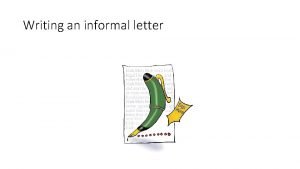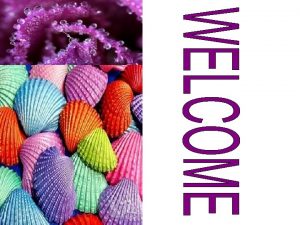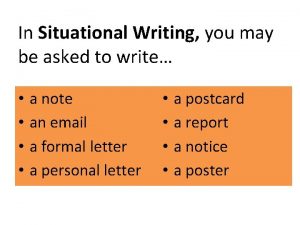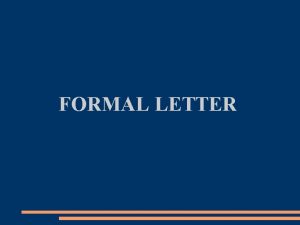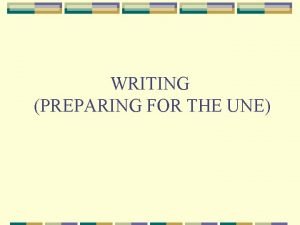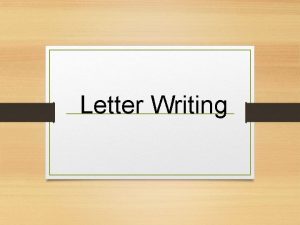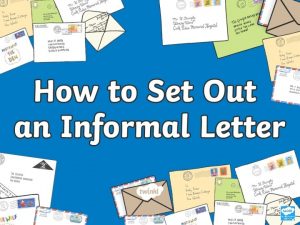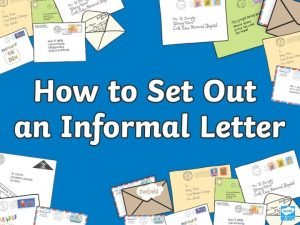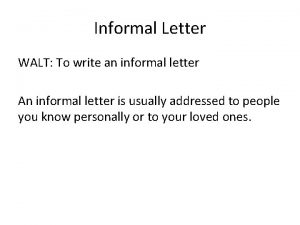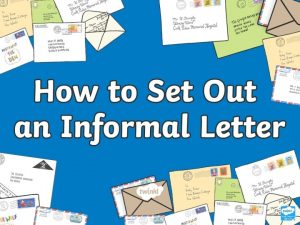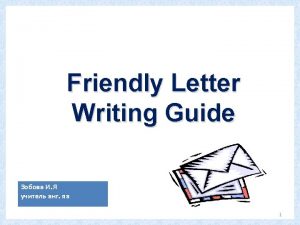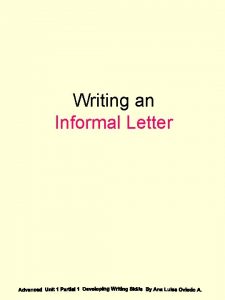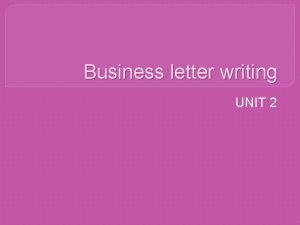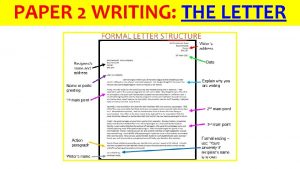Lesson 3 Informal Letter Writing I can explain















- Slides: 15

Lesson 3: Informal Letter Writing • I can explain how an informal letters are structured. • I can identify the features of an informal letter, analysing the content and language. • I can plan an informal letter. Label the features of the letter

Key Vocabulary: To be able to identify the difference between formal and informal writing Formal informal To be able to identify the features of a formal letter. colloquial To be able to identify the features of an informal letter. S Letter Address date slang To be able to plan and draft a letter in role as a character. To be able to edit and publish a letter.

1 hp 2 hp 3 hp Punctuation Retrieval Grid Write the contracted form of “where is” Change this sentence into indirect speech. “I demand that they be counted again!” reported the governor, slamming her fist on the table. Change the adverb in this sentence. “You must not forget your suitcase. You need to pack tomorrow. ” Write two antonyms of anxious. What does the root word “struct” mean in this family “structure” “reconstruct”? When should you use an adverbial phrase? Identify the determiners in this sentence- Darcey carved an intricate boat to prepare for the predicted flood. Identify the relative Add inverted commas pronoun in this to this sentence- I can’t sentence- As I entered, believe how lucky you there was a sign which have been can you? made me anxious Exclaimed the nurse as “Beware! Enter at your she looked at my own risk”. fractured elbow.

1 hp 2 hp 3 hp Answers Write the contracted form of “where is” Where’s Change this sentence into indirect speech. The governor, whilst slamming her fist on the table, demanded that the votes were counted again. Write two antonyms of anxious. Calm, brave When should you use an adverbial phrase? When you want to add more information to a sentence. What does the root word “struct” mean in this family “structure” “reconstruct”? Build. Identify two determiners in this sentence- Darcey carved an intricate boat to prepare for the predicted flood. “an”, “to” Change the adverb in this Identify the relative pronoun in sentence. “You must not Add inverted commas to this sentence- As I entered, forget your suitcase. You need sentence- “I can’t believe how there was a sign which made to pack tomorrow. ” lucky you have been can you? ” me anxious “Beware! Enter at You must not forget your Exclaimed the nurse as she your own risk”. suitcase. You need to pack looked at my fractured elbow. “which” soon.

Informal Letter Definition: Informal letters are letters written for casual or personal communication. Informal letters have a more relaxed, friendly, unofficial style than formal letters. Try and unjumble this letter:

Task 2: Like yesterday, as we go through the correct order of the jumbled up letter, we will be talking through the structure of an informal letter. Use a flow map to map out how an informal letter should be written. As we go through each slide, add another box to your flow map. In the frame of reference, write any key tips or ideas you get.

Answer: 1. SENDER’S ADDRESS The address of the sender should be written in the top right hand corner of the letter. The receiver should know where to write back to! Directly underneath this should be the date. In British English, this is written as day/month/year, e. g. 24 th August 2018. In American English, this is written as month/day/year, e. g. August 24 th 2018.

Answer: 2. OPENING After the address, the first step is to address the reader. Often, ‘Dear’ is written before the name, however in an informal letter this is not imperative. The name by which you address the reader depends upon how well you know them. For the opening section of the letter, use your imagination! Often, people begin with questions such as ‘how are you? ’ The opening section should also set up the general idea and tone of the letter – e. g. why you are getting in touch or how you are feeling.

Answer: 3. BODY You are now into the main body of the text. This is where you go into real detail, expanding upon what was written in the opening. Remember that as this is an informal letter, the topic and tone should remain relatively chatty, as in a verbal conversation.

Answer: 4. BODY (Connective Link) You do not have to squeeze the whole body of your informal letter into one paragraph. When you are slightly changing the subject or direction of your letter, you should change the paragraph. However, remember to use connectives to link your letter together.

Answer: 6. CLOSING The closing section of the letter should make some concluding comments – perhaps reflect upon what has been said, or really spell out the key messages of the letter. You may even invite the person to write back!

Answer: 7. SIGN-OFF Many people find the sign-off tricky, however it needn’t be. In an informal letter, your signoff statement can be something as casual as below: -I can’t wait to see you -Looking forward to hearing from you -Send my love to you -I hope that you are well You may also use an additional: ‘Best wishes’, ‘Kind Regards’, or ‘Lots of Love’ (depending on who it is to!) At the very bottom (in the centre) close with your name.

Task 3: Have a read of this example informal letter. What content and language features can you see? Consider the purpose and audience. What features does it include? When you finish, listen to the voice clip.

Task 4: You are now going to write your own informal letter, using all of the information about content, language and structure that you have gathered over the course of the lesson. Your informal letter can be a real letter to a real person (for example a relative you haven’t seen or a friend you miss) or can be entirely from your imagination (for example between two made up people, two characters from a novel/film). You may use the structure strips (as shown on the left) to help you organise your writing. Good luck!

Today I learnt: I am going to challenge myself by
 Writing a business letter lesson plan
Writing a business letter lesson plan 1 informal letter
1 informal letter How to writing informal letter
How to writing informal letter What are the objectives of letter writing
What are the objectives of letter writing A informal reply is written in person
A informal reply is written in person Situational writing
Situational writing Letter format example
Letter format example Objectives of informal letter writing
Objectives of informal letter writing Etc in formal writing
Etc in formal writing Letter writing format informal
Letter writing format informal Formal and informal letter
Formal and informal letter Formal style writing examples
Formal style writing examples Informal style
Informal style What is grass letter
What is grass letter Letter writing friendly letter
Letter writing friendly letter Inculto formal e informal
Inculto formal e informal


